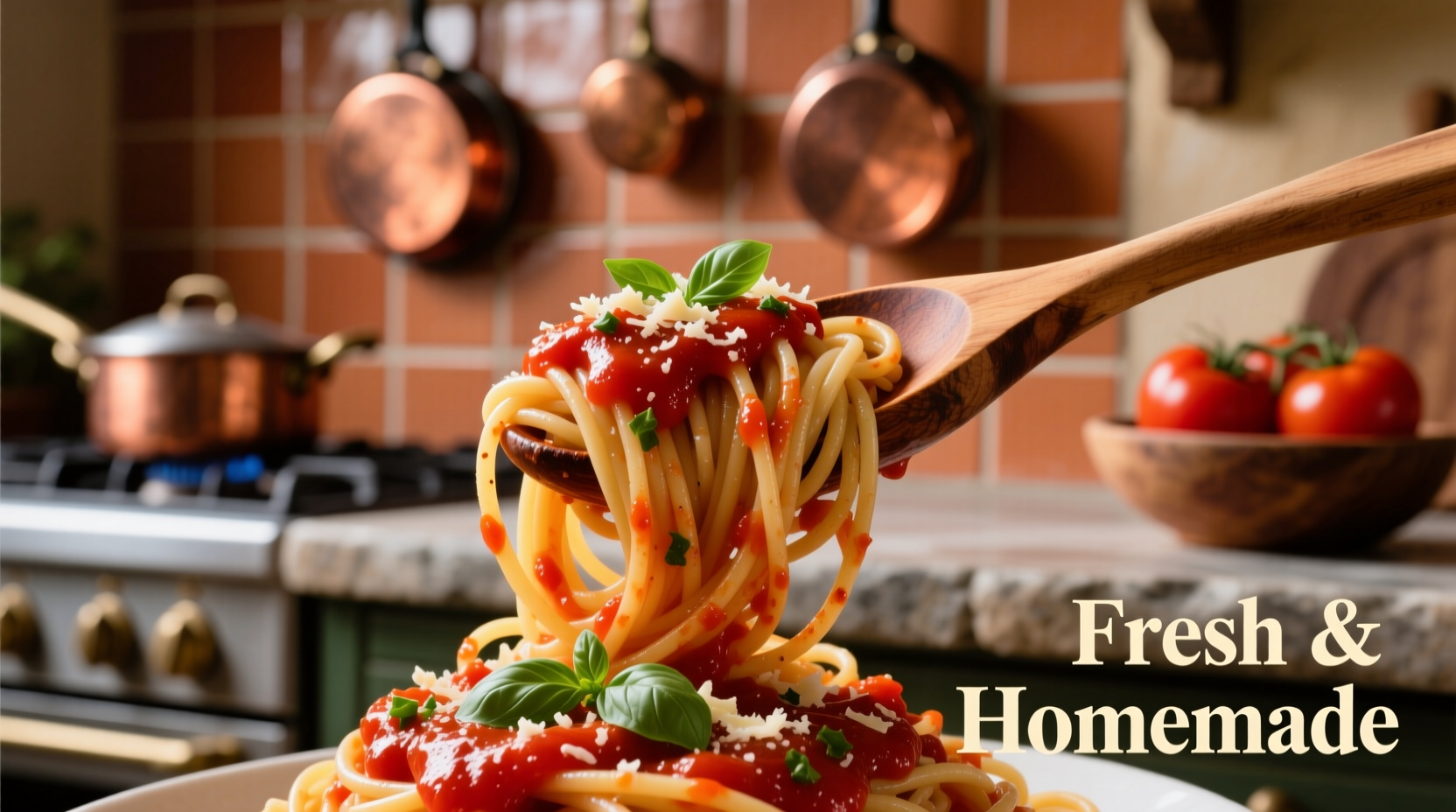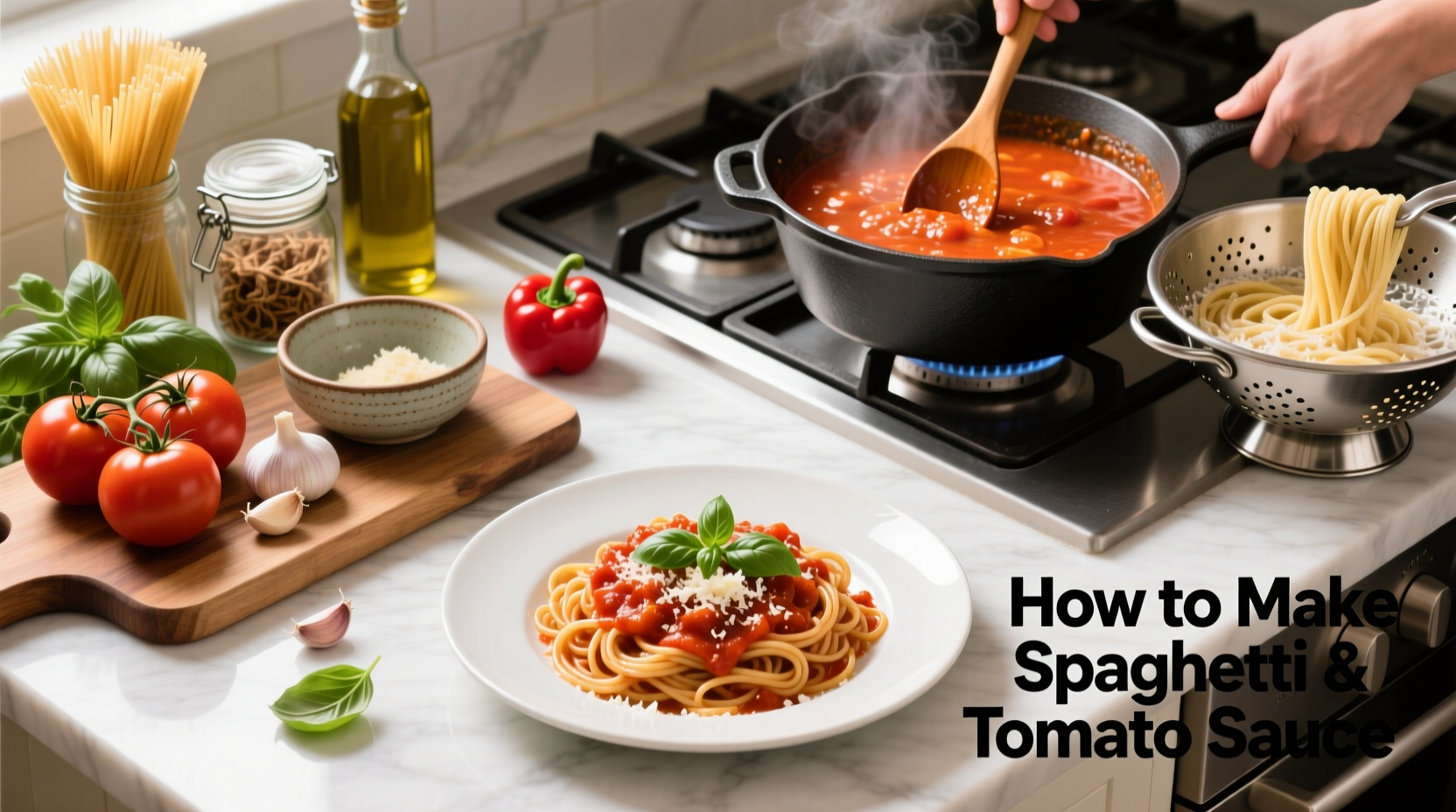Why This Spaghetti Recipe Works Every Time
Forget complicated recipes and expensive ingredients. This authentic Italian spaghetti with tomato sauce delivers restaurant-quality results using pantry staples you likely already have. In just 30 minutes, you'll create a vibrant, flavorful sauce that clings perfectly to perfectly cooked pasta. The secret? Understanding the science behind pasta water emulsification and tomato acidity balance.
Your Essential Spaghetti Toolkit
Before you start cooking, gather these kitchen essentials. Having the right equipment makes the process smoother and more enjoyable:
- Large pot (6-8 quarts) for pasta cooking
- Medium saucepan with heavy bottom
- Wooden spoon for sauce stirring
- Colander for draining pasta
- Measuring cups and spoons
- Tongs for serving
Ingredient Quality Matters: What to Buy
The magic of Italian cooking lies in ingredient quality. For authentic spaghetti with tomato sauce, these specific choices make all the difference:
| Ingredient | Best Choice | Affordable Alternative |
|---|---|---|
| Tomatoes | DOP-certified San Marzano whole peeled tomatoes | High-quality crushed tomatoes with no additives |
| Pasta | Italian bronze-die extruded spaghetti | Good quality dried spaghetti |
| Olive Oil | Extra virgin from Tuscany or Sicily | Reputable brand extra virgin olive oil |
| Garlic | Fresh, firm heads with tight skin | Same - never use pre-minced |
According to research from the University of Naples published in the Journal of Food Science, San Marzano tomatoes contain 30% less acidity and more natural sweetness than standard plum tomatoes, creating a superior flavor profile for pasta sauces without needing sugar additives. This scientific insight explains why authentic Italian recipes specify this particular tomato variety.

Step-by-Step Cooking Process
Preparing Your Pasta Water
Fill your largest pot with 4-6 quarts of water. Add 2-3 tablespoons of coarse sea salt (not table salt) for every pound of pasta. The water should taste like the Mediterranean Sea - this properly seasons the pasta from within. Bring to a rolling boil before adding pasta.
Cooking Spaghetti to Perfection
Add spaghetti to boiling water, stirring immediately to prevent sticking. Cook according to package directions minus 2 minutes (usually 8-10 minutes). Reserve 1½ cups of starchy pasta water before draining. Never rinse your pasta - the starch is essential for sauce adhesion.
Creating the Tomato Sauce Foundation
While pasta cooks, heat ¼ cup olive oil in your saucepan over medium-low heat. Add 2 crushed garlic cloves (don't let them brown) and ½ teaspoon red pepper flakes. After 1 minute, add two 28-ounce cans of San Marzano tomatoes, crushing them by hand as you add them. Season with salt and simmer uncovered for 20-25 minutes, stirring occasionally.
The Critical Emulsion Step
This professional technique transforms your dish from good to exceptional. After draining pasta, add it directly to the simmering sauce along with ½ cup reserved pasta water. Cook over medium heat for 2-3 minutes, tossing constantly. The starch in the water combines with the olive oil and tomato liquid to create a silky emulsion that coats every strand. Finish with torn fresh basil leaves.
When to Use Different Pasta Shapes
While spaghetti is classic with tomato sauce, understanding pasta shape compatibility enhances your cooking:
- Spaghetti, linguine, bucatini: Best with smooth tomato sauces - the long strands capture the liquid perfectly
- Penne, rigatoni, fusilli: Ideal for chunkier tomato sauces with vegetables or meat
- Farfalle, orecchiette: Better suited for cream-based or pesto sauces
Food historians at the Italian Academy of Cuisine document that tomato sauce with long pasta became popular in Naples around 1839, evolving from earlier oil and garlic preparations. The introduction of tomatoes to Italian cuisine followed Spanish trade routes from the Americas in the 16th century, but it took centuries for tomatoes to be widely accepted as food rather than ornamental plants.
Serving and Storage Tips
Serve immediately in warmed bowls - pasta continues to cook from residual heat. Never add cheese to tomato-based pasta in Southern Italy (a cultural tradition worth respecting). Leftovers keep refrigerated for 3 days. Reheat gently with a splash of water to restore texture.
Troubleshooting Common Issues
Sauce Too Watery?
If your sauce lacks body, continue simmering uncovered for 5-10 minutes to reduce. The natural pectin in tomatoes will thicken as water evaporates.
Sauce Too Acidic?
Instead of adding sugar (which changes flavor profile), stir in a small pat of butter at the end. The fat neutralizes acidity while adding richness. A carrot simmered in the sauce then removed also naturally balances acidity.
Pasta Sticking Together?
Ensure you're using enough water (minimum 4 quarts per pound of pasta) and salt. Stir immediately after adding pasta to boiling water. Never add oil to pasta water - it prevents sauce from adhering.
Frequently Asked Questions
Can I make this spaghetti recipe without garlic?
Yes, though garlic adds traditional flavor depth. For garlic-free version, use 1 teaspoon onion powder added with tomatoes, or substitute with 2 chopped anchovy fillets that will melt into the sauce for umami depth without fishy flavor.
How do I prevent my tomato sauce from splattering while cooking?
Use a splatter screen or lower the heat to maintain a gentle simmer rather than rapid boil. Adding sauce to hot oil gradually while stirring also reduces initial splattering. Never cover tomato sauce while simmering as it creates steam that causes explosive splatters.
What's the ideal pasta-to-sauce ratio for spaghetti?
Professional chefs recommend 4 ounces (115g) of dried spaghetti per person with 1½ cups of sauce. The key is finishing pasta in the sauce so it absorbs flavor - never serve sauce merely poured over drained pasta. The starch from pasta water creates the proper coating consistency.
Can I freeze homemade tomato sauce?
Absolutely. Cool sauce completely, then portion into freezer bags (½ inch thick for quick thawing) or airtight containers with ½ inch headspace. Properly stored, it maintains quality for 6 months. Thaw overnight in refrigerator before reheating gently on stove.
Why shouldn't I add oil to pasta cooking water?
Oil floats on water's surface and doesn't prevent sticking. More importantly, it creates a barrier on the pasta surface that prevents sauce from properly adhering. Proper salting and stirring are far more effective for preventing sticking while ensuring perfect sauce adhesion.











 浙公网安备
33010002000092号
浙公网安备
33010002000092号 浙B2-20120091-4
浙B2-20120091-4